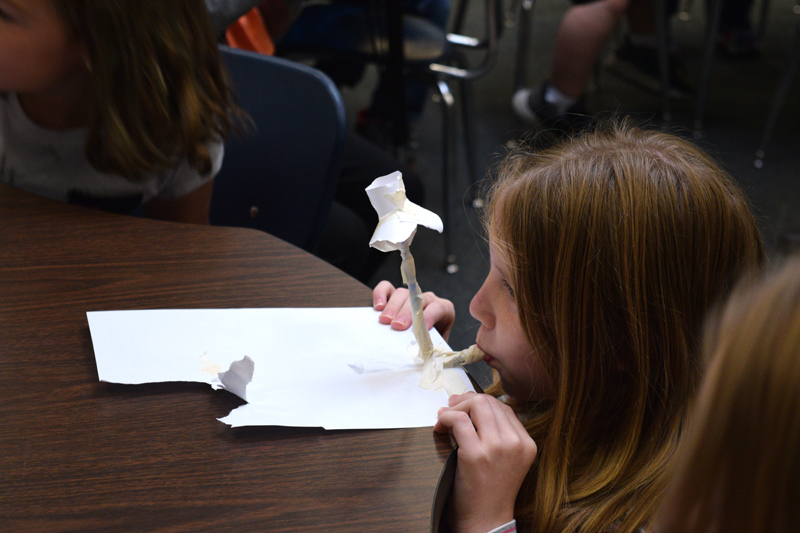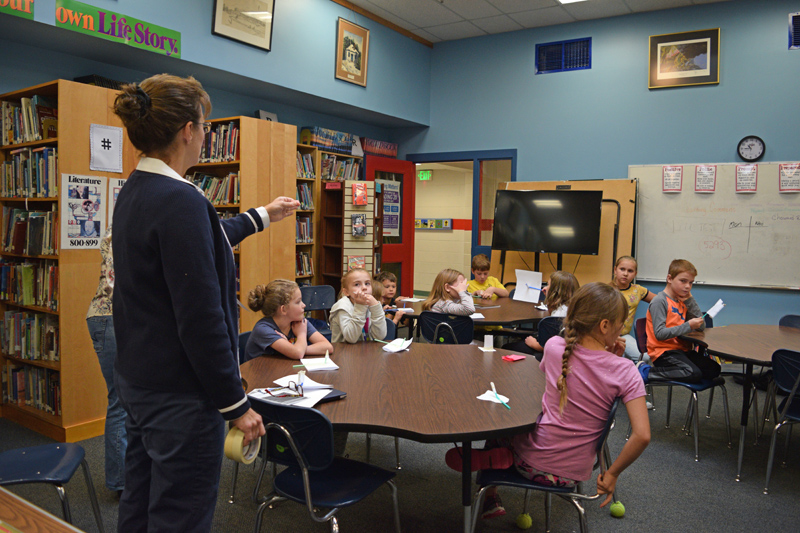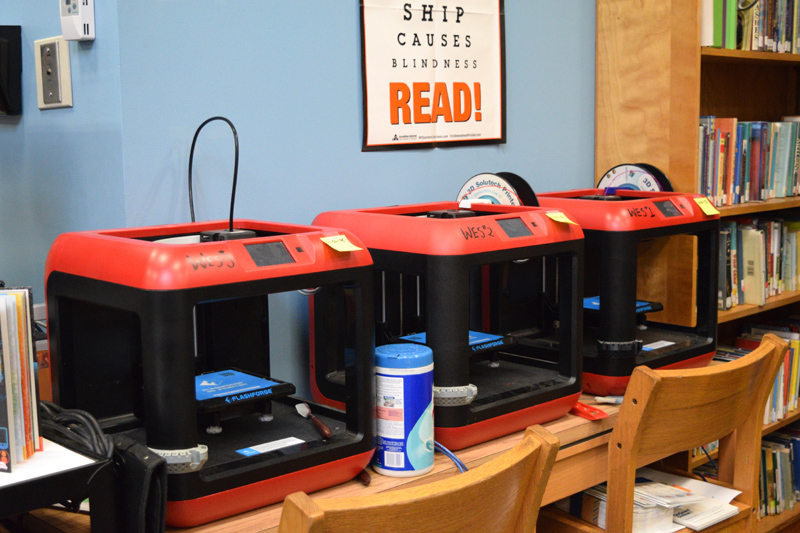
Max Hersom, a third grader at Whitefield Elementary School, attempts to build a rocket out of paper, a straw, and tape. (Jessica Clifford photo)
A plastic straw, printer paper, and tape is all it takes to make a rocket soar for third graders at Whitefield Elementary School.
They failed at first, then a second time, and maybe a third, but by the end of the 45-minute class period, each student showed off how high their rockets could go to the rest of the class.
Analysis and hands-on problem-solving is what the school’s new makerspace is all about.
A makerspace is a collaborative room in a school, library, or other facility where making, learning, exploring, and sharing happens with high-tech or no-tech tools.
Whitefield Elementary began using its makerspace this year as part of an initiative to turn all school libraries in RSU 12 into learning commons.
Learning commons are interdisciplinary project spaces that use both technology and books.

Ava Catanzano blows a straw to make her rocket take off. The goal of the activity was to create a rocket that would take off using only a straw, paper, and tape. (Jessica Clifford photo)
The makerspace is across the hall from what was formerly called the school library and is stocked with donated craft items.
“I don’t say library. I say, ‘You’re going to get a book in the learning commons.’ The kids are getting the hang of it. They adopted it really well,” said Clarissa Howard, the new learning commons guide who oversees both rooms.
Howard has over 20 years of experience at the school. She started out as the school’s library tech. After 16 1/2 years in the library, she taught middle school math for five years. She was asked to take over this new position starting this school year.
All grades from K-8 use the learning commons twice a week. One of those days students are using the makerspace, the other day students are learning about library-centered research tools and technology.
Currently, K-6 students have a teacher come along on makerspace days, while seventh and eighth grade teachers are unable to attend due to the school’s new schedule.
This school year, students are more exposed to technology the school owns, such as the three 3D printers and 12 sphero balls, which are spherical robots capable of rolling around under the control of a smartphone or tablet. The school received most of these items through donations.
Some days in the makerspace students must complete a project, such as designing a rocket, using only paper, tape, and a straw, that must be able to fly into the air without a student physically tossing it. Other days students receive a “free day.” During a free day, students can make whatever they want using the tools available in the makerspace.

Clarissa Howard, learning commons guide at Whitefield Elementary School, asks students questions after they made rockets from paper, tape, and a straw on Friday, Oct. 4. (Jessica Clifford photo)
“It’s really encouraging them to play, explore, and make mistakes and laugh at it and continue on and have a good time,” Howard said.
She said it is surprising to see all the things students create from the various items stored in the makerspace. Some students have made pillows and castles, she said.
“I say, ‘I want you to be productive in here. I want kindness and respect. If someone’s trying something new, encourage them,’” Howard said.
Howard researches STEM or STEAM-related projects for the students to complete. STEM stands for science, technology, engineering, and mathematics, while STEAM adds art.
Other teachers take advantage of the learning commons by either collaborating with Howard or using the space with their classes.
Recently a teacher had their students create insects because they were learning about them in science class. Soon students are going to make the habitat for them, Howard said.
Howard has firsthand experience with seeing changes at Whitefield Elementary.
“It’s been nice to grow at the school and grow with it and see all the changes. This year, with the learning commons, it’s a whole new ballgame,” she said.

A row of 3D printers in the learning commons at Whitefield Elementary School. Students are using the technology more this year. (Jessica Clifford photo)
The largest transformation since she began working at the school is the amount of technology, she said. When she started working at the school in the late ’90s, it had six computers for middle school classrooms. Today there are over 180 devices, with 140 specifically for students.
With more and more powerful devices available, Howard teaches the students to use the technology with purpose.
“Now it’s … showing them all the software and tools that are on the devices, so that they make good choices in how to use it when they are doing a project,” she said.
“I’m trying to teach the kids to be professional about it,” she said. “I say, ‘You’re professional students right now.’”
According to Howard, not all schools in RSU 12 have the same technology or amount of space for their learning commons. However, they are all carrying out a similar mission.
Once a month, during early release days, all the district’s new learning commons guides meet to brainstorm project ideas, troubleshoot issues, and talk about the future of the program, Howard said.
They have a master list of projects that students have participated in at each of the district’s schools, so other programs can take advantage of them.
However, it is not all about technology and making. Howard is looking forward to encouraging students to read again, as she did in the past.
Whitefield Elementary is always looking for items to stock its makerspace. Any craft item a child could use to build something would help, as well as items one would typically throw away, such as Popsicle sticks, twist ties, old wallpaper, and paper towel tubes.



